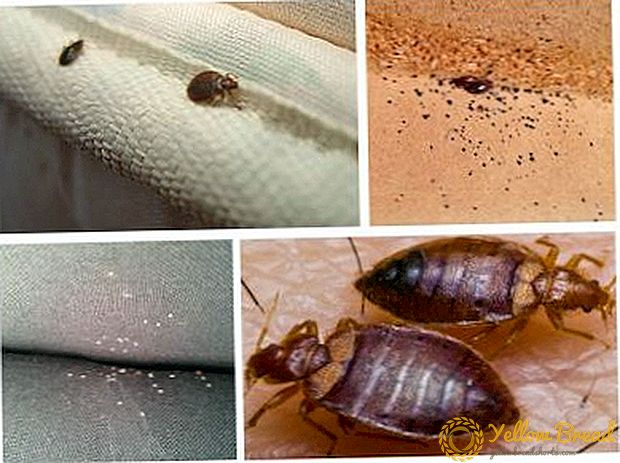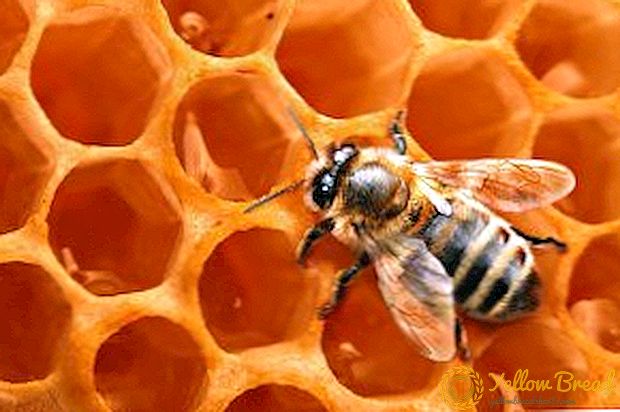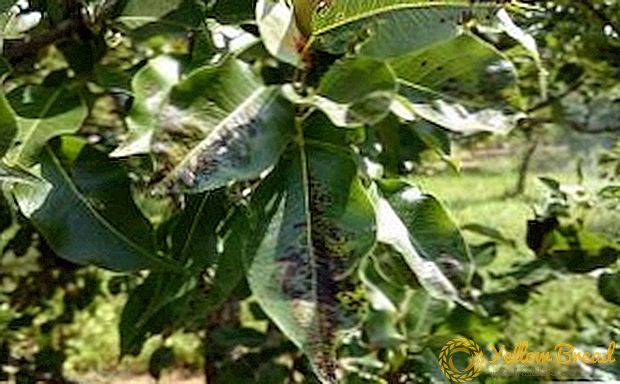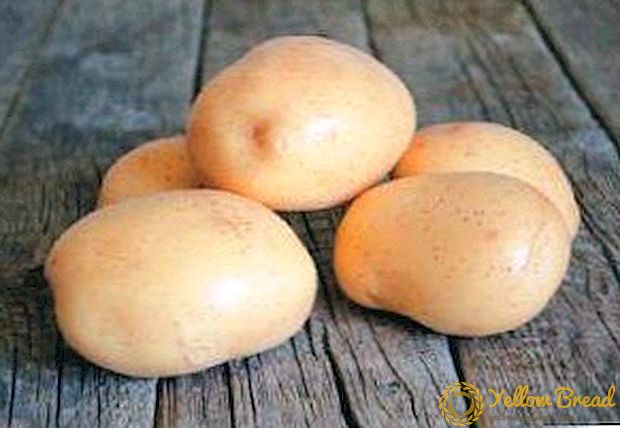
Among the many varieties of sweet cherry "Bryansk Pink" occupies a special place.
This variety appeared not so long ago in the State Register of Russia, but thanks to the taste of the fruit and their appearance, it is found on many sites of amateur gardeners today.
We will tell you more about its features and how to plant and care for a tree.
- Description of the Bryansk Pink sweet cherry variety - distinctive features
- Characteristics of the Bryansk Pink sweet cherry berries
- Description of the distinctive qualities of wood
- Distinctive features of the shoots
- Positive qualities of the variety
- The disadvantages of sweet cherry "Bryansk Pink"
- We plant sweet cherry "Bryansk Pink" on the personal plot
- The time of year for planting cherries
- Where to plant sweet cherry?
- Soil for planting
- What you need to know about the seedling?
- Direct planting of the Bryansk Pink variety sweet cherry tree
- Cherry care
- Watering rules
- How to feed cherries?
- Preparing a tree for winter
- How to protect cherries from pests and diseases
- Wood pruning
Description of the Bryansk Pink sweet cherry variety - distinctive features
This variety was obtained thanks to the efforts of scientists of the Scientific Research Institute named after Lyupin, among which are such famous breeders as A.I. Astakhov and M.V. Kanshin.For breeding varieties "Bryansk Pink" were used seedlings of cherry "Muscat Black", known by another name - "Negritenok". Since 1993, the variety Bryansk Pink has received its zoning mainly in the Central Region.
Characteristics of the Bryansk Pink sweet cherry berries

Fruits of this variety in mature form they reach medium size. Their weight ranges from 4 to 5.5 grams. The height of the berries on average is 2 centimeters, width - 2.1. The shape is sweet rounded with the same rounded top, which makes its appearance very beautiful. They are characterized by a medium-sized funnel, an average stem in length and thickness. The main color of the skin of the fruit is pink, there is a characteristic speckled pattern over the entire surface of the berry.
The flesh is yellow in color. The structure of the pulp is dense and juicy, characterized by cracking. Fruit juice is colorless and almost transparent. By taste, they are very sweet. Professional tasters rated 4.1 points. 100 grams of fruits contain about 14.2 mg of vitamin C, which makes them very useful for consumption.
And the ratio of acids to sugars in the biochemical composition of cherries is expressed as 1:20.By the way, according to their purpose, the berries are universal, suitable not only for use in writing in fresh form, but also for various types of preservation.
Bone near the berries Variety "Bryansk Pink" has an ovoid shape, with a rounded tip and base. It weighs an average of 0.27 grams, which is equal to 7.3% of the total mass of the berries. Differs in light brown color and average degree of separability from pulp.
Description of the distinctive qualities of wood
Tree varieties grow slowly, but by the 5th year enters the first fruiting. In fruiting age, it has a medium size. Sweet Crown It has a wide pyramidal shape, has very strong main branches. In addition, the branches are raised at an acute angle to the trunk, creating an average degree of crown thickening. It has many fruit-bearing formations, which in this variety are bouquet twigs.
Tree yield varieties "Bryansk Pink" average, due to the small size of the tree and fruit. The average harvest of ripened fruits per hectare is 55 centners, but the maximum numbers of favorable years are 103 centners.During the flowering period, the tree enters late, which also causes very late ripening of the berries. The tree is not capable of self-pollination.

Distinctive features of the shoots
Young cherry sprouts "Bryansk Pink", which in the fertile period grow quite intensively, is very even and smooth surface. Color shoots light brown. The buds, which are formed on the shoots, are of medium size and ovoid in the vegetative period, and oval in the generative period. Petiole has medium size, thickened., Covered with pigmentation. The leaves are large in size and green in color.
Inflorescencesformed on the bouquet branches, consist mainly of three flowers. The flowers are very small in size, have a saucer-shaped rim. Flower petals do not touch each other, differ in snow-white color. Calyx of a flower of this sort of glass cherries in shape. A distinctive feature of the flowers are their rather long pistils and stamens.
Positive qualities of the variety
Gardeners call the great dignity of the variety the restrained growth of the tree, which in the first years of fruiting gives more than its strength not to the growth of branches and shoots, but to fruiting.Also, a tree and its flower buds have a fairly good level of resistance to winter and spring frosts. Another advantage of the Bryansk Pink sweet cherry tree is the high degree of stability of the trunk and skeletal branches against sunburn, as well as against the frost.
Berries varieties are moderately affected by rot. There is a high resistance of the variety to the defeat of coccomycosis, moniliosis. Very rarely, it is affected by the most common disease of cherries, nodules. Also, they do not crack when heavy precipitation and humidity. There is a high transportability of cherries.
The disadvantages of sweet cherry "Bryansk Pink"
The only disadvantage of the variety is its inability to self-pollinate. Thus, along with this variety of sweet cherries in your backyard you will have to plant other varieties of this type of garden trees. The best pollinators for "Bryansk Pink" will be such sweet varieties as "Iput", "Ovstyuzhenka", "Tyutchevka" and "Revna".Also, the pistils of this class can be very affected if during the flowering period the temperature drops below 3 ° С.
We plant sweet cherry "Bryansk Pink" on the personal plot
In order for the fruit tree to bring abundant crops, it is necessary not only to choose the right variety, but also to plant it correctly. After all, planting includes not only the process of burrowing a young tree into the ground, but also choosing a good sapling, preparing a pit, choosing a soil, a specific place for planting and the time of year. Therefore, if you decide to plant on your plot cherries "Bryansk Pink", first of all you should carefully read the following instructions.
The time of year for planting cherries
Usually, garden trees are transplanted to a permanent growth site. spring or autumn. But still, each type should have an individual approach that will take into account the degree of their ability to take root and endure frosts.

Cherries are recommended to plant in early spring, after the final melting of the snow. As soon as the soil has moved away from the frosts, and you can start digging it - immediately dig a hole under the cherry seedling.If you plant a tree in early spring, it will be able to take root very well and by the time of the onset of autumn frosts it will already be a strong tree with a well-branched root system.
But even in the spring, the planting process should not be delayed, since the one that has already managed to blossom in the old place, the tree will take root badly on the new one, it may be affected by various diseases and not show growth until the end of the vegetative period.
Although it is possible to plant cherries in the fall, gardeners are in a hurry to dissuade such a step. They argue their recommendation that a young sapling of a sweet cherry has large gains that are very vulnerable to low temperatures. Therefore, if a sapling can survive the winter, then in the spring he will only have a healthy trunk. If you have already purchased a Bryansk Pink sweet cherry seedling, it is better to dig it in a small groove until spring and cover it with a large layer of snow.
Where to plant sweet cherry?
Best of all, the sweet cherry takes root in the places where plenty of sunshine and no northerly cold winds. In the first case, the fruits and the tree will develop poorly, and in the second - the wind can leave you without any crop, if all the flowers are torn off.Therefore, select plots with southern or south-western slopes and plant a tree from the sunny side of the buildings.
Also, our sapling should not overshadow other trees growing in the garden. Even if you are laying a cherry orchard, the distance between the trees of one row should be no less than 3 meters. And the distance between rows - 5. In addition, for planting cherries pick up a little elevated place, or poured a small artificial mound.

Soil for planting
Sweet cherries need fertile soil that can flow well and not retain water. Therefore, clay and sandy soils are automatically excluded. But loamy soils that are well saturated with oxygen will work very well. In order for the tree to have enough air and water, the soil must be constantly loosened and watered.
In addition, the level of groundwater should be at a depth of at least 1.5 meters (otherwise you need to dig a drainage ditch). If there is no other option, like clay and sandy soil, some tricks can be used.You can simply add more sand to the first option, and vice versa - clay. And of course, make more organic and mineral fertilizers. At the same time, the preparation of this type of soil should begin 1-2 years before planting the seedling.
What you need to know about the seedling?
- It is recommended to buy a sapling in the fall, since it was at this time that a much larger number of both the varieties and the seedlings themselves are presented on the market. This will allow you to choose the best and most productive tree.
- Carefully inspect the tree - it must be visible on the place of vaccination. If there is none, then the tree was grown from a stone, and therefore there is a great danger of falling onto a completely non-varietal tree.
- It is possible to replant a sweet cherry as in one-year-old (height of a sapling of 75 centimeters), and at two-year-old age (height - 1 meter). The most important thing is the degree of development of its root system, which should have a lot of ramifications, be strong and without damage.
- When transporting, the seedling is recommended to be wound into a wet cloth, over which to wrap in a layer of oilcloth.
- And yet in the fall, it is better not to plant a sapling - follow the instructionsaccording to which a seedling for the winter is best prikopat.
Direct planting of the Bryansk Pink variety sweet cherry tree
First things first you need to prepare the soil and dig a hole. It is very good to dig up the entire plot and add about 10 kilograms of organic fertilizer (per 1 m2). Also, superphosphates and nitrate are introduced into the soil, calculated on the same area - not more than 200 grams. Acid soils are quenched with lime, contributing a total of 450 grams of this substance per square meter.
Then digging a holewhose depth must be at least 60 centimeters. The width must be appropriate. First of all we dig a stake in the bottom of the pit, which will serve as a support for sweet cherries. Next to the bottom of the pit you need to fill a mixture of soil and fertilizer. This mixture is filled up as a slide and slightly compacted. A layer of ordinary, non-fertilized soil should be poured over it.
Next, proceed to re-inspection of seedlings. If dried roots are present - lower them for 6-10 hours water and only after that plant it. Next, take a sapling and drop it into the pit. Make sure that the root neck of the tree must be located 5 centimeters above the soil level.
Slowly fall asleep the roots of the soil. Covering it in half, you should compact the earth and pour one bucket of water into the pit. Next, we fill the pit to the end, compact it and make a small roller that will prevent water from spreading. And naturally, we water a sapling, using 1-2 buckets of water.
After planting and watering the soil around the trunk of the seedling should be mulched. For this it is best to use peat or humus. This is done in order to keep the moisture longer in the ground and nourish the roots of the young tree.
Cherry care

Watering rules
Cherries love moisture, so watering should be regular, and the soil is always moist (but it is important not to overdo it). Thus, watering is recommended once a month throughout the growing season. One tree should have no less than 2-3 buckets at a young age, and 5-6 - in a stably fertile.
Regular watering should be during periods of drought. Then you can make watering up to 1 time per week.
How to feed cherries?
Fertilizing trees is often not worth it, but still 2-3 times a year do it right. Immediately after planting, the sapling will feed on fertilizers put into the pit. Therefore, in the first three years it is not required in top dressing.Only in the second year of growth in early spring, it is necessary to apply nitrogen fertilizers (urea) into the soil, in the amount of 120 grams per circumstantial circle. It is recommended to drop urea to a depth of 10 centimeters, and to moisten the soil.
On the 4th year, the tree should be fertilized in special annular grooves, into which a liquid solution of top dressing flows. In early spring, about 200 grams of urea are introduced into these furrows, and in the second half of summer, 350 grams of granulated superphosphate are added.
Preparing a tree for winter
Before winter, it is very important not only to loosen the soil, but also to water it. After all, when frost moisture will “freeze” from above-ground parts of the tree, it is the roots that will be able to support the vital activity of the cherry due to the introduced moisture.
With the falling of snow, it is very important to fill them with the whole circle of sweet cherries, in order to save the soil from deep freezing. It is recommended to protect the tree trunk from various rodents by doing it with a spruce or roofing felt.
How to protect cherries from pests and diseases
So that the tree does not hurt and is not affected by pests, it should be regularly spray with special solutions. In our country, the most frequently used drugs are those that are less harmful to future fruits. Among them, copper and iron vitriol, diesel fuel, the drug "30" and urea, as a source of nitrogen.
It is possible to counteract the defeat of fungal diseases by cutting the diseased branches and burning them. In addition, in the case of diseases, all the leaves that have fallen from the cherry tree must also be burned.
Wood pruning
In the first years of growth shoots are cut to stimulate the formation of berries. In the subsequent ones, only dry and damaged branches, which weaken the tree and still do not bear fruit, need to be removed. For the convenience and correctness of the formation of crown cherries, it is important to remove those branches that grow into its inner part. Also, shoots can grow from the roots around the trunk - they should also be regularly removed.






